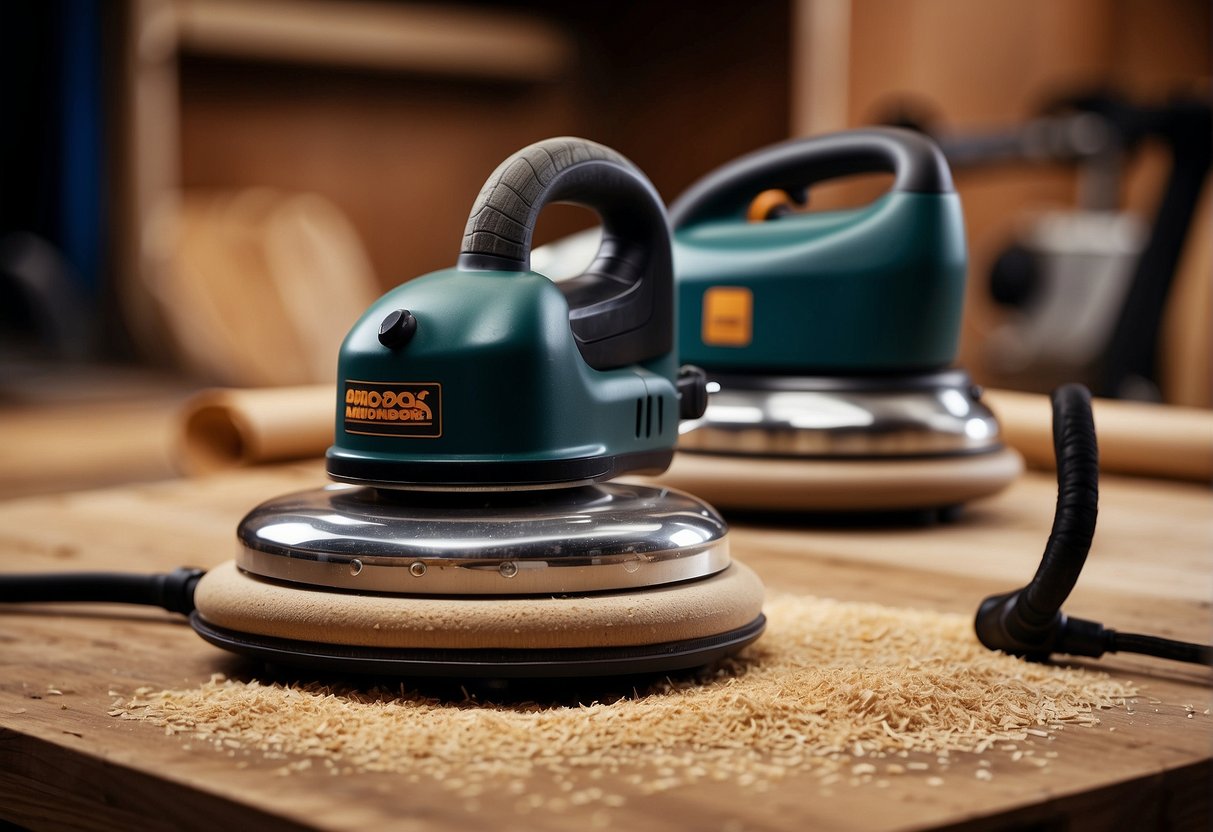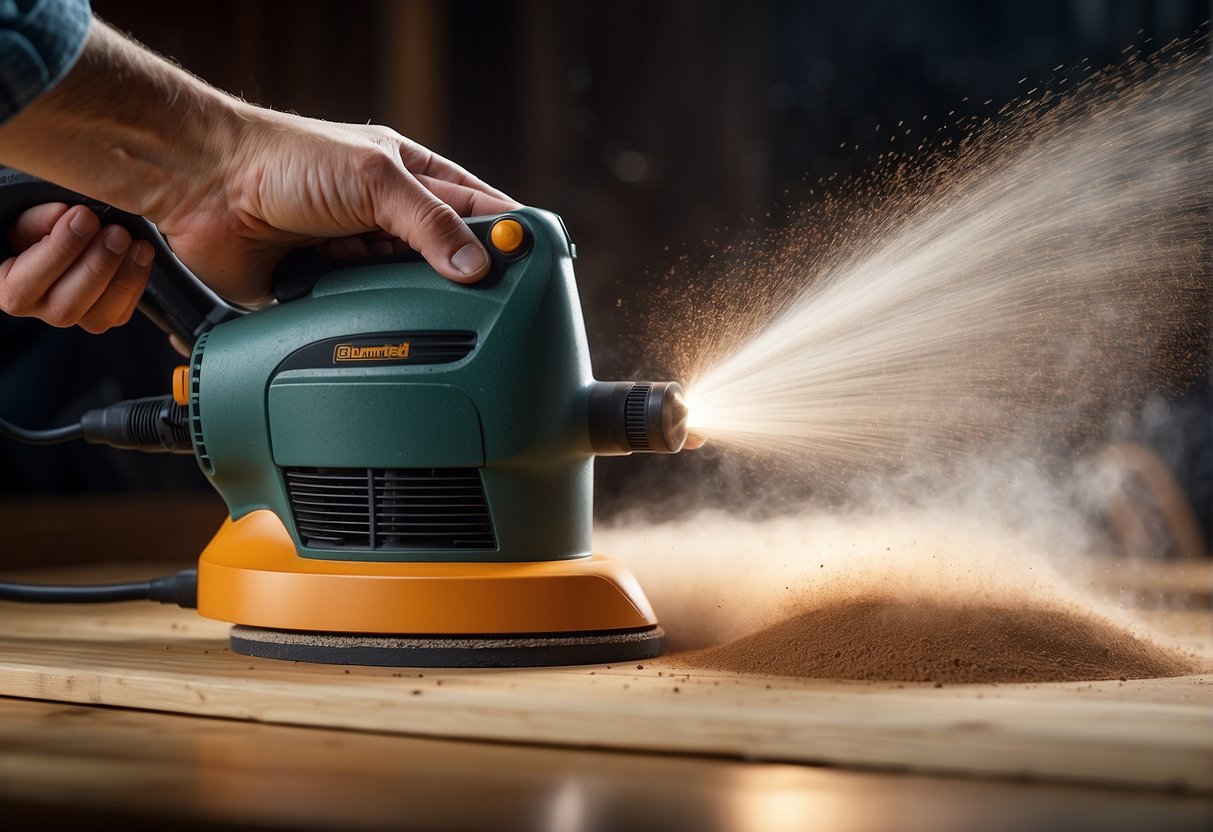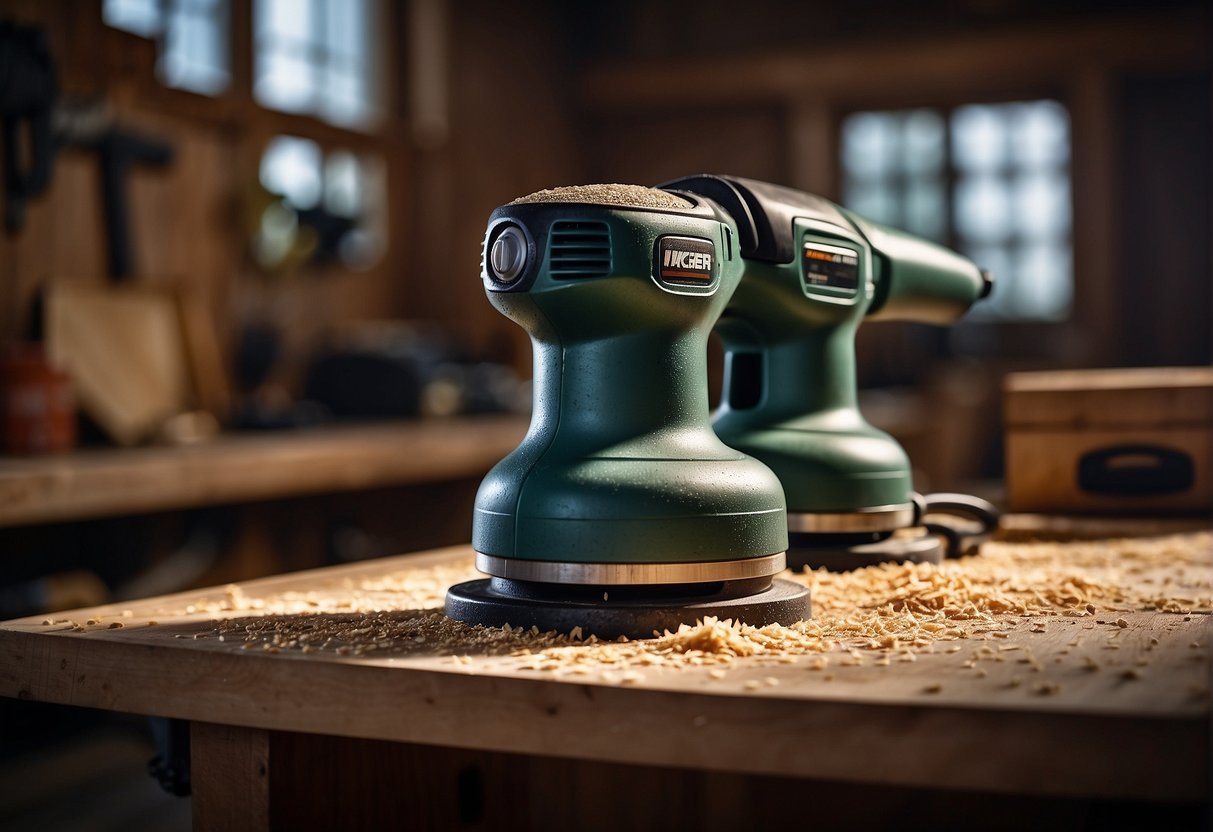When it comes to woodworking, sanding is an essential process that can make or break the final product. The right sander can help you achieve a smooth and even surface, while the wrong one can leave you with an uneven or damaged workpiece. With so many sanders available on the market, it can be overwhelming to choose the right one for your needs. Two of the most popular types of sanders are air sanders and electric sanders.
Air sanders, also known as pneumatic sanders, are powered by compressed air, while electric sanders are powered by electricity. Both types of sanders have their pros and cons, and choosing the right one depends on your specific needs and preferences. In this article, I’ll take a closer look at the differences between air sanders and electric sanders, and help you make an informed decision about which one is right for you.
Key Takeaways
- Understanding the differences between air sanders and electric sanders is essential for choosing the right sander for your woodworking needs.
- When comparing power and performance, electric sanders tend to have more consistent speed and power, while air sanders can offer higher speed but with airflow fluctuations.
- Other factors to consider when evaluating usability and convenience, cost, and maintenance can also play a significant role in choosing the right sander.
Understanding Air Sanders
Types and Applications
Air sanders, also known as pneumatic sanders, are power tools that use compressed air to operate. They come in different types, including random orbital, straight line, and dual-action sanders. Each type has its own specific application, such as removing old paint or smoothing out rough surfaces.
Random orbital sanders are the most versatile type of air sander and can be used for a variety of tasks, including sanding, polishing, and buffing. Straight line sanders are best used for sanding flat surfaces, while dual-action sanders are great for removing paint and rust from metal surfaces.
Benefits of Air Sanders
One of the main benefits of air sanders is that they are generally more powerful than electric sanders. They also tend to be lighter and more compact, making them easier to maneuver and use for extended periods of time. Additionally, air sanders are quieter than electric sanders, which can be important in certain work environments.
Another advantage of using a pneumatic sander is that it requires less maintenance than an electric sander. Because there are fewer moving parts, there is less wear and tear on the tool. However, it is important to keep the air compressor and air filter clean and lubricated to ensure that the sander operates at peak performance.
Operating Air Sanders
To operate an air sander, you will need an air compressor with enough pressure and air capacity to power the tool. It is important to match the air compressor to the specific requirements of the sander to ensure that it operates properly.
Before using the sander, make sure that it is properly lubricated and that the air filter is clean. It is also important to wear appropriate safety gear, including eye protection and a dust mask.
In conclusion, air sanders are powerful and versatile tools that are ideal for a wide range of applications. They offer several advantages over electric sanders, including greater power, lighter weight, and quieter operation. With proper maintenance and care, an air sander can provide years of reliable service.
Understanding Electric Sanders
As a woodworker, I have used both air sanders and electric sanders for various projects. In this section, I will discuss electric sanders in detail, including their types, applications, benefits, and how they operate.
Types and Applications
Electric sanders come in various types, including belt sanders, orbital sanders, and random orbital sanders. Belt sanders are powerful and efficient, making them ideal for heavy-duty sanding tasks. Orbital sanders, on the other hand, are suitable for finishing tasks and creating a smooth surface. Random orbital sanders combine the features of both belt sanders and orbital sanders, making them versatile and suitable for various tasks.
Electric sanders are suitable for various applications, including sanding wood, metal, and plastic. They are also useful for removing paint, rust, and other materials from surfaces.
Benefits of Electric Sanders
Electric sanders have several advantages over air sanders. They are more powerful and efficient, making them suitable for heavy-duty tasks. They also have a variable speed control, allowing you to adjust the speed to suit the task at hand. Additionally, they come with various accessories, such as sanding pads and dust bags, to make the sanding process easier and more efficient.
Operating Electric Sanders
To operate an electric sander, you need to plug it into a power outlet. It has a motor that powers the sanding pad, which rotates at high speeds to sand the surface. However, you need to be careful not to overheat the sander, as this can damage the motor. You should also perform regular maintenance, such as cleaning the dust bag and replacing worn-out sanding pads.
In summary, electric sanders are powerful, efficient, and versatile tools that are suitable for various sanding tasks. They come in various types, including belt sanders, orbital sanders, and random orbital sanders, and have several benefits, such as variable speed control and various accessories. However, you need to be careful not to overheat the sander and perform regular maintenance to ensure its longevity.
Comparing Power and Performance
When it comes to power and performance, both air sanders and electric sanders have their strengths and weaknesses. In this section, I will compare the power and performance of these two types of sanders.
Power Source and Output
The power source is one of the most significant differences between air sanders and electric sanders. Air sanders use compressed air to operate, while electric sanders use electricity and a motor. Air sanders generally have a lower power output than electric sanders. However, they can still be powerful tools, especially when used with a high-quality air compressor.
On the other hand, electric sanders are generally more powerful than air sanders. They can produce a consistent power output during operation, making them ideal for heavy-duty sanding tasks. Electric sanders are also more versatile than air sanders, as they can be used in a wider range of settings.
Consistency and Control
Consistency and control are essential factors to consider when choosing between an air sander and an electric sander. Electric sanders offer more consistent, even speed, which allows for greater control over the sanding process. They also offer more control over the amount of pressure applied to the surface being sanded.
Air sanders, on the other hand, can be more difficult to control. They can produce slightly more speed with a top RPM of 12,000, but airflow fluctuations can affect machine speed. However, air sanders are lighter, which can make them easier to control in certain situations.
Durability and Lifespan
Durability and lifespan are also important factors to consider when choosing between an air sander and an electric sander. Electric sanders are generally more durable than air sanders, as they are designed to withstand heavy use for extended periods. They are also less likely to break down or malfunction.
Air sanders are generally less durable than electric sanders. They are more prone to wear and tear, and they require more maintenance to keep them in good working condition. However, air sanders can still be a good investment if you are looking for a lightweight, portable sander that can be used in a variety of settings.
Overall, when it comes to power and performance, electric sanders are generally more powerful and versatile than air sanders. However, air sanders can still be a good choice if you are looking for a lightweight, portable sander that can be used in a variety of settings.
Evaluating Usability and Convenience
When it comes to usability and convenience, both air sanders and electric sanders have their own advantages and disadvantages. In this section, I will evaluate the usability and convenience of both types of sanders based on several factors.
Weight and Portability
One of the most significant differences between air sanders and electric sanders is their weight and portability. Air sanders are generally lighter and more portable than electric sanders. This is because air sanders do not have a motor, which makes them more compact and easier to handle. On the other hand, electric sanders are heavier and less portable because of their motor.
Dust Management
Dust management is another important factor to consider when evaluating the usability and convenience of air sanders and electric sanders. Both types of sanders generate a lot of dust, which can be harmful to your health if inhaled. However, some air sanders come with good dust collection systems, which can help to minimize the amount of dust generated during sanding. Electric sanders also have dust collection systems, but they are generally not as effective as those found in air sanders.
Noise and Vibration
Finally, noise and vibration are two other factors that can affect the usability and convenience of air sanders and electric sanders. Air sanders are generally quieter and produce less vibration than electric sanders. This is because air sanders do not have a motor, which produces a lot of noise and vibration. Electric sanders, on the other hand, are noisier and produce more vibration because of their motor.
Overall, both air sanders and electric sanders have their own advantages and disadvantages when it comes to usability and convenience. When choosing between the two, it is important to consider factors such as weight, dust management, noise, and vibration to determine which type of sander is best suited for your needs.
Cost Considerations and Maintenance
When it comes to cost considerations and maintenance, there are a few things to keep in mind when comparing air sanders and electric sanders. In this section, I will discuss the initial costs and value, running costs and maintenance, and cost-benefit analysis for both types of sanders.
Initial Costs and Value
The initial cost of an air sander is typically higher than that of an electric sander. This is because air sanders require an air compressor to operate, which can be a significant investment. On the other hand, electric sanders are typically more affordable and don’t require any additional equipment to operate.
However, when considering the value of the sander, it’s important to keep in mind that air sanders tend to last longer than electric sanders. This is because they have fewer moving parts and are less prone to wear and tear. In the long run, the higher initial cost of an air sander can be offset by its longer lifespan.
Running Costs and Maintenance
In terms of running costs, air sanders are generally more expensive to operate than electric sanders. This is because they require an air compressor, which can use a lot of electricity. Additionally, air sanders require more maintenance than electric sanders. The air compressor needs to be maintained regularly, and the air hoses need to be checked for leaks.
Electric sanders, on the other hand, have lower running costs and require less maintenance. They simply need to be plugged in and turned on, and they don’t require any additional equipment or maintenance.
Cost-Benefit Analysis
When it comes to cost-benefit analysis, the decision between an air sander and an electric sander ultimately comes down to your specific needs and budget. If you’re looking for a sander that will last a long time and can handle heavy-duty work, an air sander may be the better choice, despite its higher initial cost and maintenance requirements.
If, on the other hand, you’re looking for a more affordable and low-maintenance option, an electric sander may be the way to go. Electric sanders are also more portable than air sanders since they don’t require an air compressor, making them a good choice for those who need to move their sander around frequently.
In conclusion, both air sanders and electric sanders have their pros and cons when it comes to cost considerations and maintenance. It’s important to carefully consider your specific needs and budget before making a decision.
Frequently Asked Questions
What are the advantages of using an air sander over an electric sander?
Air sanders are typically lighter and easier to use, as they do not have a motor or electrical components. They also tend to produce less vibration, making them more comfortable to use for extended periods. Additionally, air sanders are often more affordable than electric sanders, making them a popular choice for DIYers and hobbyists.
How does a pneumatic sander work and what applications is it best suited for?
A pneumatic sander, also known as an air sander, uses compressed air to power the sanding disc. The air is supplied by an air compressor, which is connected to the sander via a hose. Pneumatic sanders are best suited for applications that require a high degree of precision and control, such as auto body work, woodworking, and metalworking.
Can electric sanders be effectively used for auto body work?
While electric sanders can be used for auto body work, they are generally not as effective as pneumatic sanders. This is because electric sanders tend to produce more vibration, which can make it difficult to achieve a smooth finish. Additionally, electric sanders are often heavier and more cumbersome than pneumatic sanders, which can make them difficult to maneuver in tight spaces.
What are the key differences between orbital sanders and other types of sanders?
Orbital sanders are a type of finishing sander that use a circular sanding disc to remove material from a surface. Unlike other types of sanders, such as belt sanders or drum sanders, orbital sanders do not leave visible sanding marks on the surface. Additionally, orbital sanders are typically lighter and easier to use than other types of sanders.
Which type of sander is more suitable for woodworking projects?
Both pneumatic and electric sanders can be used for woodworking projects, depending on the specific application. For rough sanding and material removal, a belt sander or drum sander may be more appropriate. For finishing and smoothing, an orbital sander or random orbital sander may be a better choice.
How do air sanders compare to electric sanders when used on metal surfaces?
When used on metal surfaces, air sanders are generally more effective than electric sanders. This is because air sanders tend to produce less heat, which can cause the metal to warp or distort. Additionally, air sanders are often more precise and controllable than electric sanders, which can be important when working with metal.

Hi, I’m Sal Muller of Tooltrip.com. My DIY experience led me to understand essential power tools for home projects. Tooltrip.com guides enthusiasts and professionals in choosing right tools for any job. I provide concise top tool reviews for easier, efficient DIY.






